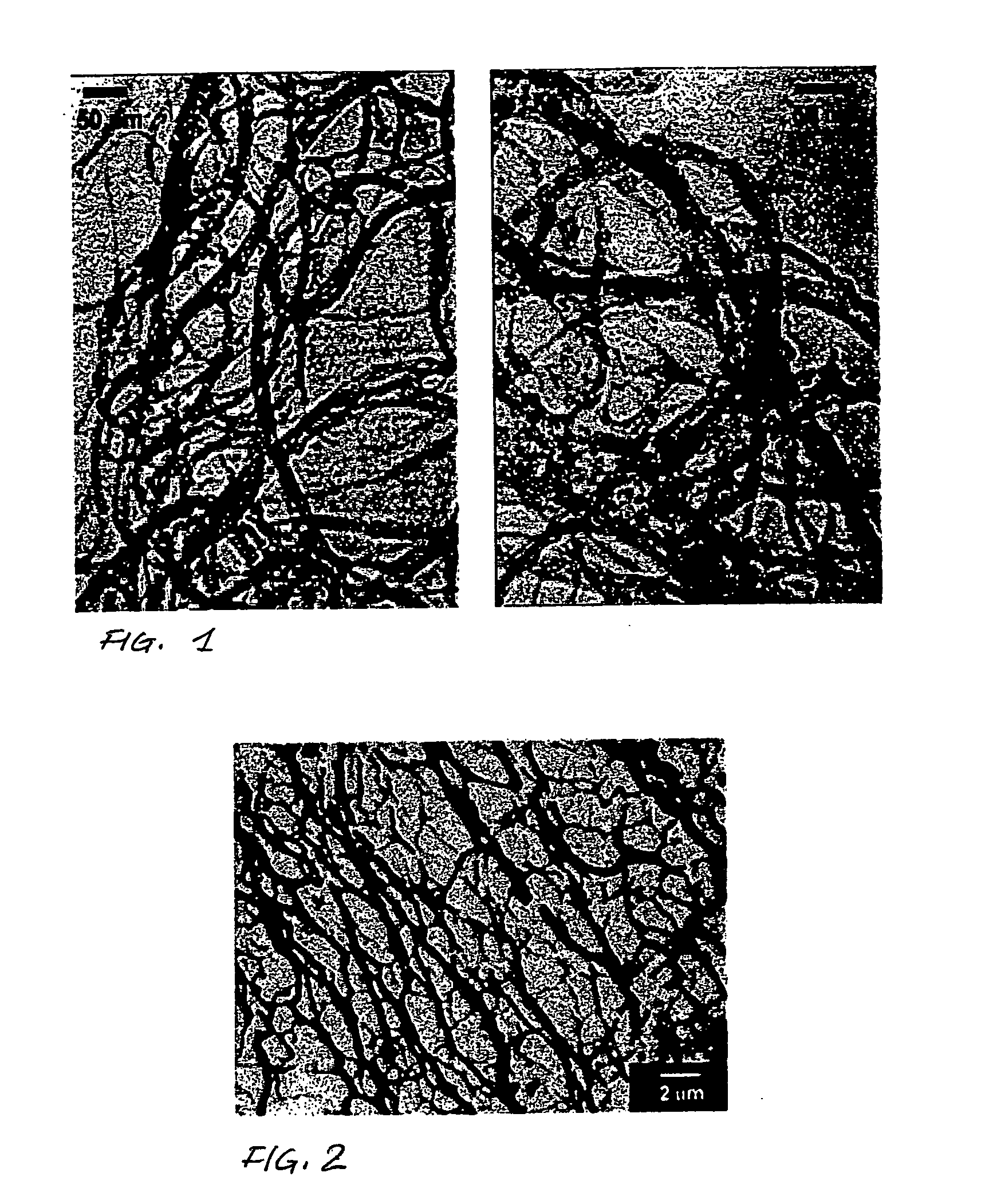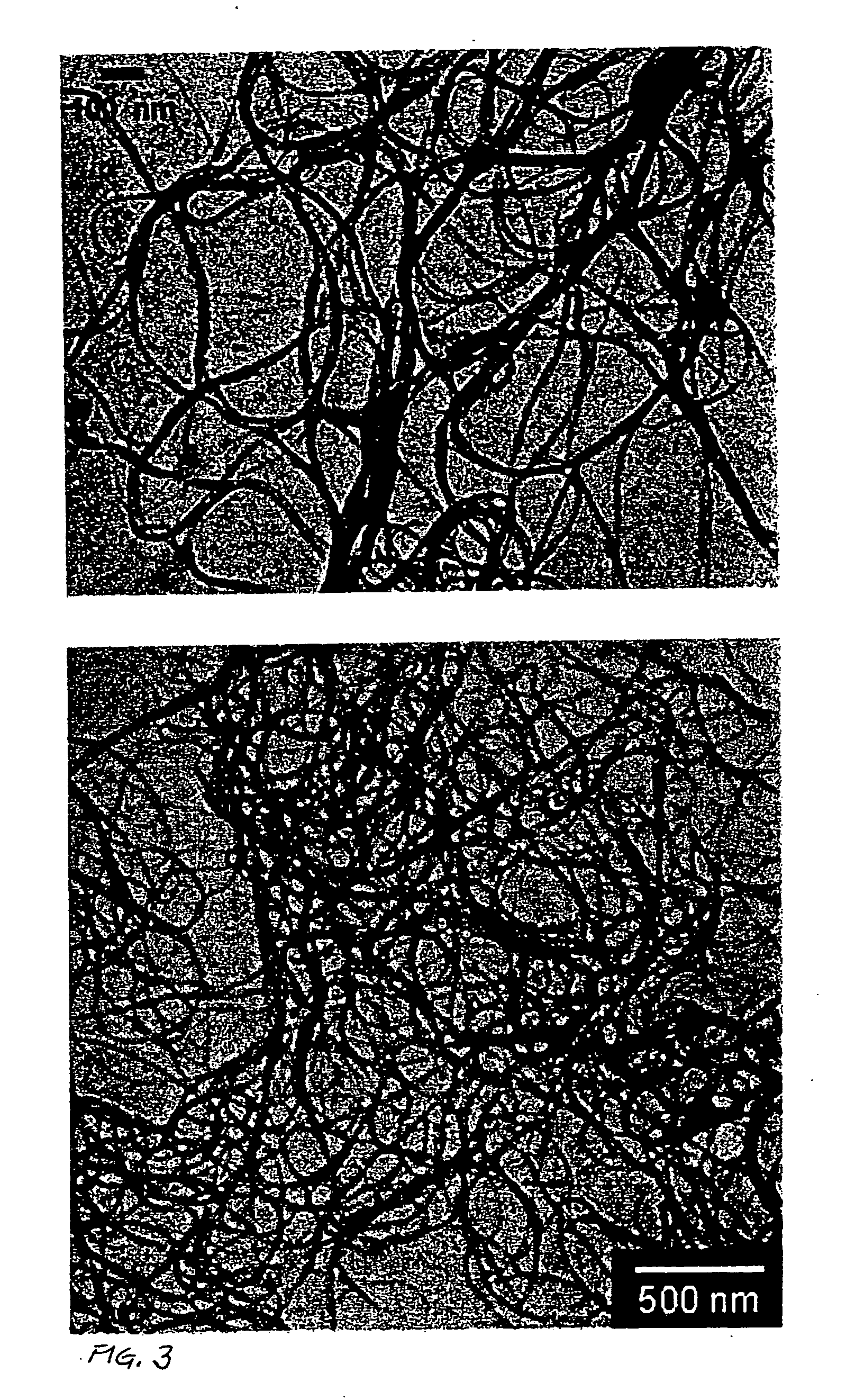Purification process of carbon nanotubes
a carbon nanotube and purification process technology, applied in the field of carbon nanotube purification process, can solve the problems of insolubility of contaminants, serious limits to their study and many uses, and the impairment of nanotubes, and the difficulty in overcoming the problem of insolubility
- Summary
- Abstract
- Description
- Claims
- Application Information
AI Technical Summary
Problems solved by technology
Method used
Image
Examples
example 1
Organic Functionalization Reaction
[0030] 100 mg of SWNT carbon nanotubes are suspended in 300 ml of dimethylformamide (DMF). The mixture is heated to 140° C. and a solution of N-octylglycine ethyl ester in DMF (500 mg in 10 ml) is added in portions of 2 ml every 24 hours with 500 mg of paraformaldehyde each time. Lastly, after 50 hours, 500 mg of N-octylglycine ethyl ester and 2.5 g of aldehyde are added to the initial suspension. The mixture is heated for a further 72 hours.
example 2
Organic Functionalization Reaction
[0031] 1.00 mg of SWNT carbon nanotubes are suspended in 300 ml of dimethylformamide (DMF). The mixture is heated to 140° C. and a solution of N-methylglycine in DMF (500 mg in 10 ml) is added in portions of 2 ml every 24 hours with 500 mg of n-heptaldehyde each time. Lastly, after 50 hours, 500 mg of N-methylglycine and 2.5 g of aldehyde are added to the initial suspension. The mixture is heated for a further 72 hours.
[0032] In both examples the organic phase is separated by filtration on paper under vacuum and the solution is transferred to a rotary evaporator where the DMF is removed quantitatively. The remaining brown oily residue is diluted in 200 ml of dichloromethane and washed with water (5×200 ml). The organic phase is dried over Na2SO4 and after being filtered (to remove the Na2SO4) the solution is concentrated under vacuum. The residue is dissolved in 2 ml of dichloromethane and subsequently 10 ml of methanol is added to the mixture. Th...
example 3
Purification of Functionalized Nanotubes
[0037] 80 mg of functionalized nanotubes according to example 1 and obtained using N—(CH2CH2OCH2CH2OCH2CH2OCH3)-glycine with paraformaldehyde are dissolved in 300 ml of CHCl3. In this way a transparent brown solution is obtained. Diethylether is added in drops to the solution under stirring at ambient temperature. This is added until a precipitate appears. The solution is filtered and diethylether is once again added. The precipitate is recovered from the paper filter dissolving it in CH2Cl2. After the CH2Cl2 has evaporated, the solid material is washed with diethylether, centrifuged and dried under vacuum. This procedure is repeated three times; three precipitates (P1, P2 e P3) are obtained. Moreover, after evaporation of the chloroform, the material that had not yet precipitated (S) is also obtained in solid state.
[0038] The precipitates P1, P2 and P3 appear respectively after the addition of 480, 300 and 300 ml of diethylether, each of th...
PUM
| Property | Measurement | Unit |
|---|---|---|
| Temperature | aaaaa | aaaaa |
| Temperature | aaaaa | aaaaa |
| Time | aaaaa | aaaaa |
Abstract
Description
Claims
Application Information
 Login to View More
Login to View More - R&D
- Intellectual Property
- Life Sciences
- Materials
- Tech Scout
- Unparalleled Data Quality
- Higher Quality Content
- 60% Fewer Hallucinations
Browse by: Latest US Patents, China's latest patents, Technical Efficacy Thesaurus, Application Domain, Technology Topic, Popular Technical Reports.
© 2025 PatSnap. All rights reserved.Legal|Privacy policy|Modern Slavery Act Transparency Statement|Sitemap|About US| Contact US: help@patsnap.com


